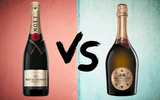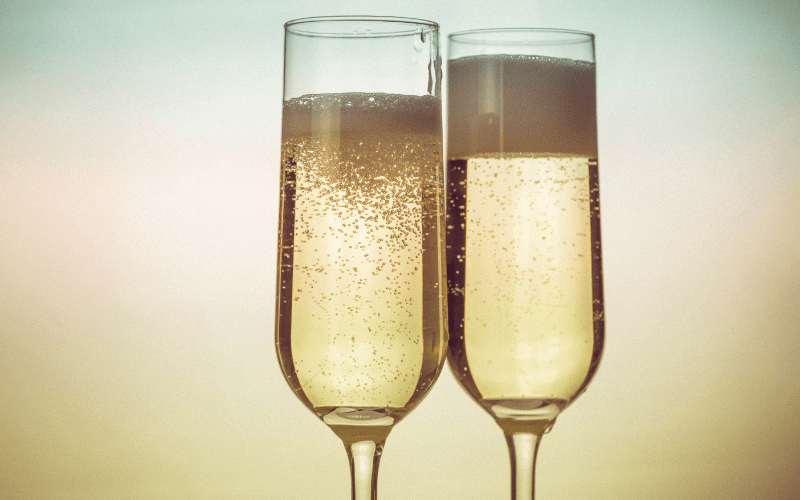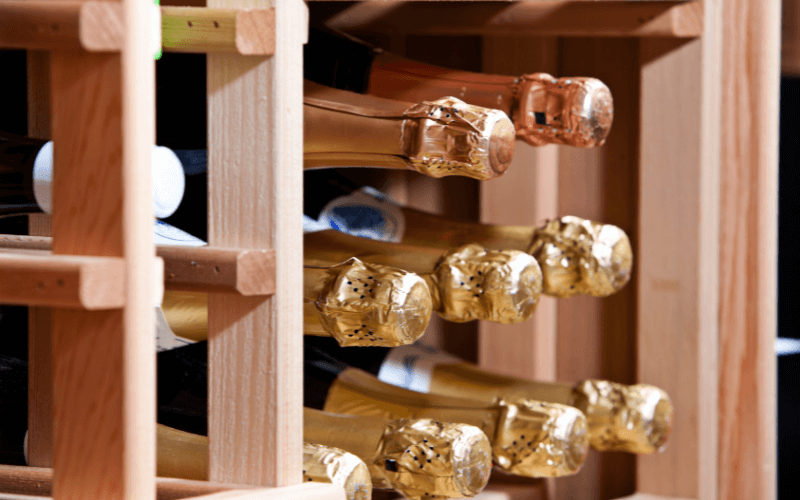
Champagne Vs. Prosecco: Which Sparkling Wine Is Better?


When you see a flute glass filled with sparkling wine, do you immediately think that it's Champagne? How can you be sure that it's not Prosecco? Both wines look alike, but with a more thorough investigation, you'll be surprised by their many differences and similarities.
In this post, we will compare Champagne vs. Prosecco using several categories. We'll also determine if one has the edge over the other or if they are equal. If you want to know more, keep reading to find out which type of sparkling wine you should be drinking!
|
Category
|
Champagne
|
Prosecco
|
|
Region |
Champagne, France |
Veneto, Italy |
|
Climate of Vineyards |
Cold |
Warm |
|
Price |
$40 - $300 |
$10 - $30 |
|
Grapes |
Pinot Noir, Pinot Meunier, Chardonnay |
Glera |
|
Process |
Méthode Champenoise |
Charmat Method |
|
Tasting Notes |
Citrus, almonds, toast |
Pears, apples, honeydew |
|
Alcohol By Volume |
12% - 13.5% |
10.5% - 13% |
|
Bubbles |
Persistent and lively |
Soft and light |

Champagne is made in a particular wine region of France of the same name, located about 90 miles northeast of Paris. It's worth noting that only wines from this region can be called true Champagnes, and they're made using the regulations set out by standards bodies.
The story of how Champagne became one of France's most famous wines starts with an unlikely event. To cut the long story short, a monk named Dom Pérignon accidentally carbonated the white wine he was making.
There is still debate about this occurrence, but one thing's for sure: one thing for sure: bubbly wines were popping up by the late 1600s throughout France!
When you open up your bottle of Champagne, the bubbles will dance around in perfect unison with each other. It's not difficult to see how this delicate but firm wine has been able to hold on for so long as one of the most popular beverages!
Phenomenal flavor complexity lies at hand here. Almond-like notes are present alongside subtle hints of orange zest and white cherry flavors, which all come together into something truly exquisite.
Choosing a bottle for a special event can be a bit overwhelming. So, to help you make a decision, here are some of the most famous Champagne brands: Moët & Chandon, Nicolas Feuillatte, G.H. Mumm, Taittinger, and Piper-Heidsieck.
For some, drinking Champagne is an indulgence reserved for very special occasions. For others who love bubbly but don't have the same outlook on life as those with selective tastes or budget worries, this can be hard to swallow!

Italian wine is no stranger to variety, and Prosecco is one of the most popular. Prosecco is a sparkling wine that originates from the region of Veneto in Northern Italy. Some producers outside this region have used the term "Prosecco" to describe their wines.
These products are technically not true Proseccos since they don't meet the certain criteria established by Italian law for what constitutes as such. Only those produced within Veneto and Friuli Venezia Giulia regions will do!
The history of Prosecco is a long and interesting one. Records show that this Italian wine has been around for centuries, being enjoyed by many Romans in ancient times, such as Pliny the Elder, who called it "one of the great wines of the day."
Prosecco is a refreshing wine that tends to have more fruit and flower aromas because it’s made from the Glera grape. The best bottles offer up tropical fruits such as fresh cream with hazelnut vanilla notes too.
This sparkling wine has been growing in popularity for years and is now outpacing all other types of wines worldwide!
Furthermore, it is often an excellent compromise in searching for affordable bubbly. Here are some famous brands to get you started: La Marca, Distilleria Bottega, Zonin, Bellissima, and Canella.
Prosecco is a great way to enjoy before and after your meal. You can have it as an elegant, sophisticated aperitif or a pairing with select desserts that will leave you feeling satisfied.

The residents of Reims, Épernay, and other villages in Champagne are proud creators who know their own territory best. This means only they can produce some of the most world-renowned Champagnes.
The climate in the Champagne region is usually cold, which means that the grapes tend to have higher acidity as they ripen. This also allows them to accumulate less sugars, resulting in a fresh and clean taste. However, this kind of climate can also cause a low yield of grapes.
Such grapes may not fully ripen at the time of harvest during long winters, prompting winemakers to add sugar to the must during fermentation to reach the required alcohol levels.
Meanwhile, the wines of Northeast Italy can be traced back to a small region in Veneto called Conegliano Valdobbiadene. This region is a veritable emblem of Italy's wine culture, where vineyards produce crisp, delicious, and the best Proseccos.
The climate here has been recognized as warm, temperate, or Mediterranean—and rainfall can be experienced all year round, even during summer. This allows the grapes to grow and ripen quickly, accumulating more sugars for flavor and body.
Proseccos are made in a special microclimate surrounding Valdobbiadene. They're much cooler than other parts due to all that rain there, giving wines delicious crispiness for your taste buds.
Moreover, the diverse landscapes in the region and the different soils (limestone, clay, marl, and marine sandstone) provide a perfect cultivation location for Glera grapes.
With this, the Veneto region wins this round since climate and soils are perfect for growing Glera, which means an abundance of harvest.

Champagne can either be a single varietal or a blend using three types of grapes: Pinot Noir, Pinot Meunier, and Chardonnay.
Pinot Noir is a red grape that is typically used for red wines. The skin on this thin-shelled delicacy imparts a richness to the Champagne while the flesh is responsible for the structure, berry-like flavors, and aromas.
Pinot Meunier grapes are also a red grape variety that gives the Champagne its fruity and floral aromas. Finally, Chardonnay grapes are green-skinned and commonly used to make white wine. It is responsible for providing the Champagne a delicate touch, finesse, and lightness.
Other vineyards all around the globe may still cultivate the three grapes. However, the only grapes allowed to make Champagne are those grown in France's wine-producing region of Champagne.
In contrast, the grapes that go into Prosecco wine must come from 85% of Glera grapes. Other grape varieties can be used to make up the remaining 15%, such as Chardonnay and Pinot Noir.
The aromas and characteristics of Glera can be altered, depending on where it is grown. Naturally, Glera is a semi-aromatic variety, but when they're cultivated on a vineyard with a flat surface and unrestricted yields, they can be neutral.
The combination of Champagne grapes allows the beverage to have numerous possible ratios that result in a spectrum of different flavor profiles. The three grapes are in equal proportion most of the time, but they can also vary.
There are also types of Champagne that only use an all-white grape variety (e.g., 100% Chardonnay), called Blanc de Blancs, or an all-red variety, called Blanc de Noirs.

One of the secrets to making the perfect sparkling wine is its production process. Champagne uses the traditional method, also known as Méthode Champenoise. The process begins with a batch of early picked grapes that give more tart flavors.
The traditional method allows your Champagne to undergo a second fermentation in the bottle. Then it's made by mixing sugar and yeast, releasing carbon dioxide gas that pressurizes into the container. This is what gives Champagne its fizz.
After this process is completed, it will be aged using either lees or riddling, depending on what type was used during production! Then, your soon-to-be Champagne undergoes disgorgement and dosage.
When wine bottles disgorge, they go into liquid nitrogen or frozen brine to freeze the lees. Its purpose is to ensure that any deposit leftover from the remuage process has been eliminated.
Then, the final touch to perfecting a bottle of Champagne is dosage, which goes into the bottle to refill the lost content and also adds balance to the Champagne.
On the other hand, Prosecco is a cheaper and more accessible drink because of its process. It follows some of the steps of making Champagne, but with one notable difference - it is processed using the tank method or Charmat method, which is more affordable.
The tank method is a cost-effective way to produce sparkling wine because instead of second fermentation in bottles, it occurs in large tanks, speeding up the production process. This tank is then sealed for carbonation to build up and create fizz.
If the question is about the quicker, cheaper, and more efficient process, one will go with Prosecco. The Charmat method creates affordable yet high-quality drinks, producing less hassle.

When drinking Champagne, you can generally enjoy citrus fruits, almonds, toast, and white peach with a little bit of cherry thrown in. Prosecco also has its own unique set of flavors - from green apple and honeydew to honeysuckle and pear!
Champagne ages on the lees or dead yeast cells before being released. This aging process creates qualities similar to cheese rinds and toast, with the latter being recognized in finer bottles of Champagne.
Prosecco has a more floral and fruity taste. This is because there's less pressure in Prosecco tanks, and there is less exposure to lees, making way for fruit attributes. You will notice that most fine bottles of Prosecco have notes of tropical fruit, hazelnut vanilla, or banana cream.
Champagne and Prosecco both have their own unique taste profiles. So, this round goes to both beverages since the two have different taste characteristics, and there are no standard tasting notes that everybody should be fond of.
After all, taste is subjective, and preferences vary from person to person. The next time you drink both Champagne and Prosecco, you be the judge of their flavors!

Champagne and Prosecco both have the same dryness/sweetness scale and labels. Champagne and Prosecco have seven key levels of sweetness: brut nature, extra brut, brut, extra dry, dry, demi-sec, and doux.
Brut nature and extra brut are on the dry side, whereas brut, extra dry, and sec/dry all have hints of sweetness. The last two, demi-sec and doux, are the sweetest types.
Since both have essentially the same dryness/sweetness levels and terms, there's no point in pointing the finger at one winner.

Champagne is known for being refreshing and fizzy. It's like what Dom Perignon said when he tasted his first Champagne creation, “Come quickly, I am tasting the stars!” And he said it just after one sip! But what exactly makes it so?
The secret lies with Méthode Traditionelle or the traditional method. It features a high-pressure carbonation process that creates long-lasting Champagne bubbles in your drink, making it perfect for celebrating life events or just enjoying it during parties.
On the other hand, Prosecco bubbles are derived from the Charmant Method, wherein the secondary fermentation takes place in large stainless steel tanks. These tanks don't have much pressure on them, thus producing lighter carbonation which usually fades quickly.
In the world of sparkling wine, Champagne is arguably the most bubbly. The fizz or bubbles is a key experience when you're drinking it, and Champagnes express more perlage. That's why this round goes to Champagne!

Food pairing is a tricky business. There are certain guidelines for drinking Champagne and which foods complement its flavor.
The perfect pairing of Champagne is all about balance. Salty and savory snacks are the best way to treat your palate between sips of Champagne without sacrificing flavor!
Prosecco is delicious with cheese, seafood, or cured meats. It also goes great as the perfect aperitif before your next dinner! With its fruity flavor and affordable price tag, it's an ideal alcohol choice for anyone looking to get their drink on without breaking the bank.
For this category, it's okay to let two winners take home the crown. The two have their own unique aromas and tastes that contribute to their food pairing ability. They're both versatile and perfect for different kinds of dishes.

Sparkling wines usually have a lower alcohol content than still wines. This is because the grapes used for the former are harvested earlier than those used for the latter, resulting in lower sugar content. This ultimately leads to a low ABV created during fermentation.
The standard ABV for a bottle of Champagne is about 12% but can go up to 13.5%. While it's not as high as other types of liquor, it can make you feel tipsy quickly if not prepared properly or if you have had too many Champagne glasses.
The alcohol content in Prosecco varies, but the average is also around 12%. Some variations have as low as 10.5% or as high as 13%.
If you're looking for a light, and crisp beverage that features fruit flavors and wonderful aromas, then you can go for either Champagne or Prosecco. Since there is only a minor difference between Champagne and Prosecco's ABV, it's only fair to let this round be a tie.

It is widely known that Champagnes are rich in bubbles, arguably making people love them so much. But did you know that they already make champagnes with intentionally no bubbles?
It may sound wrong since Champagne has been synonymous with bubbly since its rise to fame. But believe it or not, they exist, and a couple of individuals have already claimed to be fans.
Although still Champagnes are not yet known or acknowledged yet by the masses, they hold a lot of potential and will receive recognition someday.
Prosecco has three main types or styles - Spumante, Frizzante, and Tranquillo. The difference between the three of them is the level of effervescence. Spumante wines have a higher level of effervescence than Frizzante ones, while Tranquillo has zero bubbles or is still.
These days it's a rare find to find a still Prosecco, but they do exist and are more recognized than still Champagne. Tranquillo literally translates to "calm," which describes the wine being calm and still, denoting the lack of bubbles.
Furthermore, both Prosecco and Champagne are available as sparkling Rosé.
If we were to base this round on the number of styles or types, then Prosecco takes this round. It has more options to offer, catering to different tastes or preferences.

Champagnes rarely come cheap, and the average price for decent bottles ranges from $40 to $300. The most exquisite bottles can cost thousands and hundreds of thousands. If this is not expensive enough, you'll be surprised to know that they can even reach millions.
Prosecco is much better for your wallet or bank account. Good but cheap Proseccos can be under $20 and go up to $30. Expensive bottles of Prosecco can also reach the $100+ price point, and the priciest bottle yet is about $1,700.
There is a very good reason that Prosecco is more affordable than Champagne, and it has everything to do with the process.
The process of transforming grapes into a delicious glass of Champagne is far more complicated than most Prosecco wines. It will take longer, but it's worth the effort when you taste this sparkling beverage!
Méthode Traditionnelle is a time-consuming and laborious process that requires aging wine, meaning you have to hold onto your inventory. You also incur all of the costs associated with storing these. Also, Champagne exclusively uses grapes of excellent quality.
Champagne might be the more popular sparkling wine and gets branded as elegant and high-end, but in terms of affordability and practicality, Prosecco has the spotlight.
There are various Proseccos out there that have the same quality as some Champagnes, if not better.

Sparkling wines are a great asset to bartenders and mixologists in making cocktails, and each one is used for distinct beverages. For instance, French 75 makes use of Champagne, while Cynar Spritz is made with Prosecco.
However, both can be used interchangeably in many cocktails, such as in Mimosas. Usually, when Champagne is not available, one can substitute it with Prosecco, and vice versa. Since both have great versatility and application in sparkly cocktails, they both win this round.
Looking at the categories above, you'll notice that most of them resulted in a tie. However, Prosecco has a slight advantage in price and style. It's true that Prosecco has great appeal to the people, mainly because it is more accessible and affordable.
However, people have been accustomed to popping open a bottle of Champagne whenever there are celebrations. If price is not an issue, some people will choose Champagne over Prosecco any day.
Ultimately, the choice between Champagne vs. Prosecco rests entirely on the drinker and his means and purpose.

